Periodically, J.D. checks to see what topics readers are searching for in earlier posts. One that always seems popular is Spanish blackwork. It just so happens that there has been a good bit of interest in the subject lately. Also, I have gotten both a request for new blackwork patterns and a question about using them, so I am going to address those issues today.
First of all, I want to present some new blackwork patterns. These are designed primarily to fill larger areas of design than many of the ones we have shown previously. It takes several repeats of the design elements to really display the pattern properly. These would show up well on checked gingham, for example. If you want them to appear smaller and denser, you will need something like #14 needlepoint canvas or a comparable Aida fabric. I suggest you practice by drawing each design at least once on a piece of graph paper before you begin stitching it. Then you will have the paper patterns for future reference.
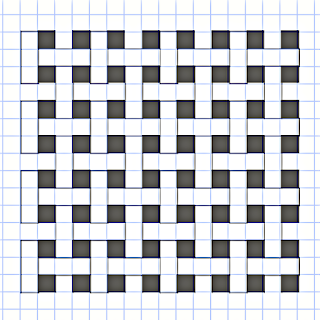 |
| Blackwork stitch pattern 1 |
This open-weave design not only covers large areas quickly, but also can give an optical illusion of depth. If I were doing this, I would stitch around all of the woven pieces first. Then I would put three or four closely packed upright stitches in to fill each square between them. This would look like a dark background some distance behind the lattice. If you don't want to create the illusion, then put an X, a plus sign, or an asterisk (made by combining the X and the plus} in each of the small squares to complete the pattern.
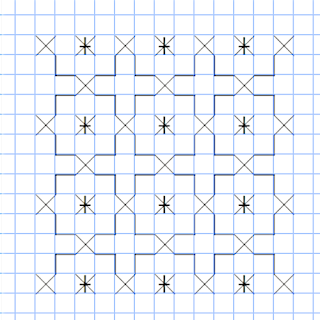 |
| Blackwork stitch pattern 2 |
This next pattern is a true tiling pattern. If you draw the large squares with points, you will create the shapes between them without further drawing. Conversely, if you draw the in-between shapes correctly, you will create the squares without further drawing. The little asterisks in the squares just add texture to the design.
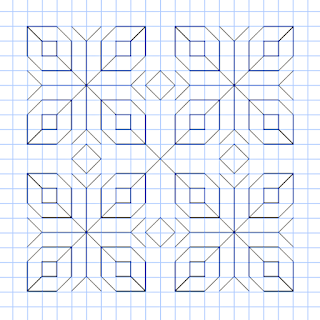 |
| Blackwork stitch pattern 3 |
The last pattern is a large one that can be used alone as an all-over pattern for a pillow, baby carriage cover, or an even larger article. It can be made considerably smaller by using fabrics with a much higher thread count. Either way, it requires concentration. I really recommend that you work this one out on graph paper before you begin stitching. You may want to do it in two steps. Step 1 would be to draw in the long-stemmed Y shapes that form the North, East, South and West supports of the design. Add the X at the center of the design. Step 2 is to draw the ‘petals’ at the four corners of the design. Step 3 puts in the small diamond shapes and the X-shapes between the motifs. Notice that the arms of all the X-shapes extend through the motifs to make diamond shapes connecting the motifs. It is important that these lines be as straight as possible. To make this more visible, draw Steps 1 and 3 in a dark green pencil or pen, while you do the Step 2 ‘petals’ in a bright color. This chart will help you even if you are going to do the whole design in black later. Used at a smaller size, the motifs create another type of illusion. While you will only use straight stitches to construct the design, the illusion will form that you have used curved lines to make it.
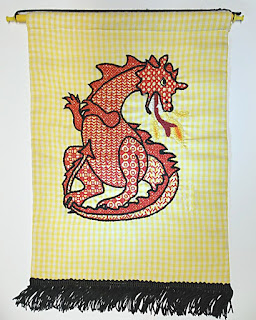 |
| "Little Red Dragon", embroidery on checked gingham |
The question I got was: "Can I do blackwork patterns in other colors?" The answer is most emphatically "Yes!" There was a time when similar pattern stitching was done in red in countries like Russia, Poland, Lithuania, Latvia and Estonia. It came to be known as Russian Redwork. A friend who has traveled to Russia assures me that pieces adorned with this type of embroidery are still being sold at the Moscow airport. I do my own version of it, as you can see in my baby dragon.
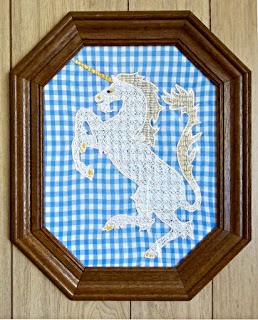 |
| "Unicorn", embroidery on checked gingham |
Scandinavian needle workers do exquisite surface embroidery — often combined with cut work — in white on both white and colored fabrics. Again, I do my own version, as you can see in my rampant unicorn. I did not do any cut work on this picture because it did not seem appropriate. I did use a heavy gold thread for the unicorn's horn and a lighter one on the mane, tail, hooves, nostril and around the eye. I made the eye itself with a dark blue French knot.
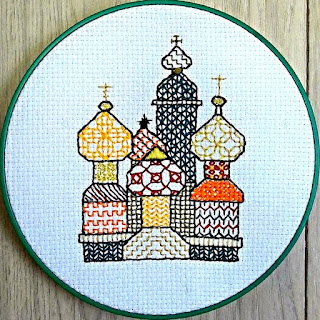 |
| "Colorful Onion Domes", embroidery on monk's cloth |
When the patterns are done in multicolor, the work is called Holbein embroidery. To be strictly legitimate, Holbein embroidery involves using a stitch that covers both sides of the fabric (
see our August 20, 2014 post), but you can do a very good simulation using the traditional blackwork stitching. Here is my blackwork "Onion Domes" pattern done in multicolor.
If you think you may have missed some of our past blackwork patterns, simply go to our search engine ("SEARCH MY BLOG" in the sidebar), type in the words “blackwork pattern” and press Search. When you come to the bottom of the first set of posts, click on Next Posts and follow that procedure until you reach a point where there are no more posts with patterns. Not everything the search gives you will be pertinent: search engines can be rather erratic in their selections. But you should find some useful charts. If you are just starting to do blackwork, or if you are still deciding whether you like it, follow the same search procedure using the term “blackwork” alone to get all the tutorials and other useful tips.
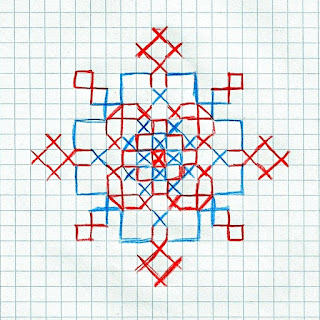 |
| Hand-drawn draft of a complex pattern in two colors |
Finally, here is another color technique I use when designing complex patterns that expand from a central design. The colors make it clear where each round of stitches begins and ends so that I don't produce a lop-sided, uneven pattern. Such a pattern, when completed, can be done as blackwork or in two or more colors.
In fact, I liked
that idea so much that a did a new pattern for you in all the colors of the rainbow!
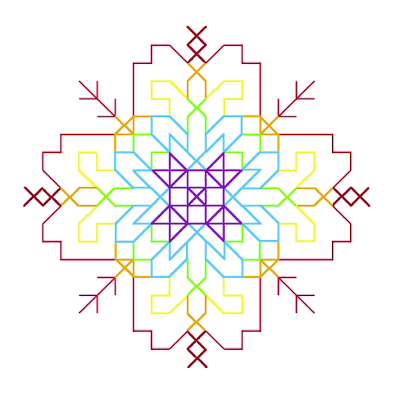 |
| New stitch pattern in rainbow colors |
Use your patterns to make something unique.
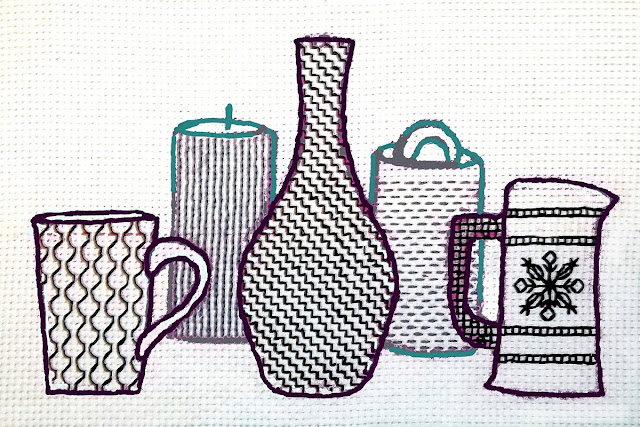








 This post by Annake's Garden is licensed under a Creative Commons Attribution-NonCommercial-ShareAlike 3.0 Unported License.
This post by Annake's Garden is licensed under a Creative Commons Attribution-NonCommercial-ShareAlike 3.0 Unported License.
I am determined to take up blackwork and am excited to find your blog. Thank you for making these available and for your wonderful notes.
ReplyDelete